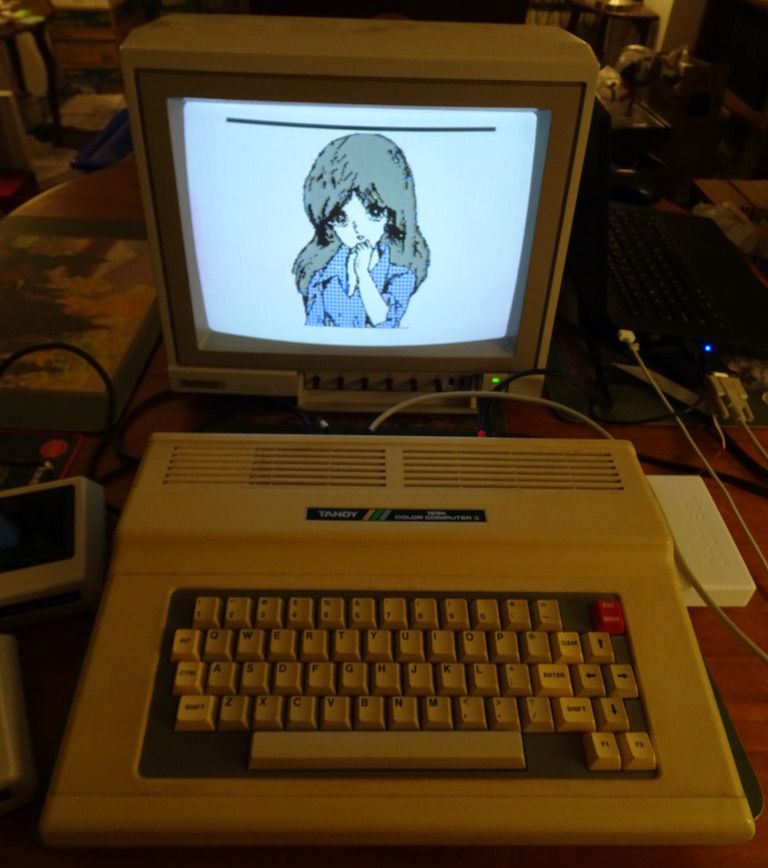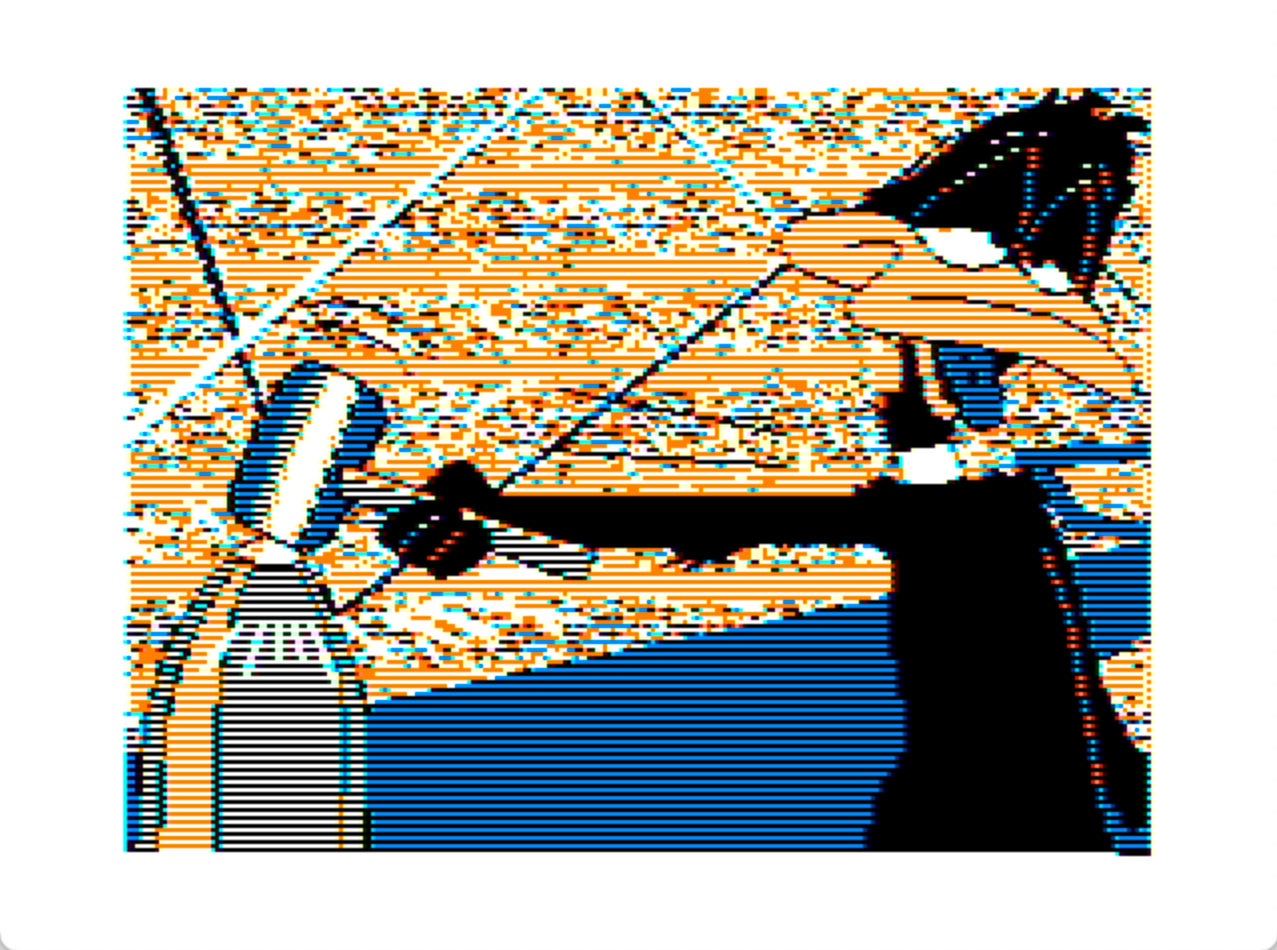Trying for the Home Team
Feb. 12th, 2021 06:16 pmDiscovering a relic archive of RLE images hadn’t been aimed at “the broadest possible audience” (of people viewing pictures on their computers in the mid-1980s, anyway) had been an odd amusement for me, if only because I supposed myself in the audience the collection had been assembled for. Shorn of context (including the historical), an RLE image by itself might not seem that much. Not only are they black-and-white only, their data has to be read into a fixed space 256 pixels wide by 192 pixels high. The Apple II magazine article I’d first noticed the images described in mentioned this had been a sort of lowest common denominator befitting online ambitions, and I accepted that in a casual way. A while later, though, in going back to an article in a Commodore magazine, I spotted the comment that size matched the highest resolution of the original TRS-80 Color Computer, my family’s computer at the time. There was a peculiar sting to that. I’d long known the Color Computer’s graphics weren’t that sophisticated (powered by an off-the-shelf Motorola chip recognizable in a few other computers and peripherals), but the clear suggestion it was “the lowest common denominator” did rankle. Then, though, I rallied. I’d already tried viewing RLE images through emulation of the Apple II, Macintosh Plus, and TRS-80 Model 4, and that had seemed sufficient. Now, however, I intended to get them on a “CoCo” screen.
To start off, I looked in the “Color Computer Archive,” where I did find a terminal program with “RLE” in its name. Its documentation, though, gave me the impression it could only display an RLE image sent over the serial port. Before long, however, I did remember I’d installed a simple terminal program on an old black-plastic MacBook when trying to connect to an even older portable. With a Color Computer 3 still set up on my dining room table, I put everything else together, tried transmitting an RLE file from the MacBook via the “send text file” option, and saw the “CoCo” program switch to the graphics screen by itself and draw the image dot-by-dot. With its serial port’s slow speed (it’s long been called “the bit-banger”), I also got a clearer sense of just how long it would have taken to load images over the phone line back in the day. I did notice some of the images I had could invoke the Color Computer’s familiar two “artifact colours,” although I can’t say for sure they had somehow been meant for that computer alone. (The Apple II also produced colours by drawing black-and-white vertical pinstripes, although without care those colours would be green and purple, a bit sicklier than blue and red.) Along with that, however, it also seemed the program would lock up as soon as one image was complete. I did keep wondering if there was another option; one that would work in emulation would be nice, too.

The Apple II magazine article had included a type-in program short enough to not feel intimidating even as it suggested how simple “RLE encoding” was. After trying it out in Apple II emulation, I started pondering using it as inspiration for a Color Computer program. While what “CoCo boosting” I’ve seen did seem to focus on “hobbyist computing,” it at least gave me the impression Disk Extended Color BASIC had capabilities the built-in languages on many other computers lacked. However, on taking a closer look at the original program I developed the impression Applesoft BASIC could read a data file of arbitrary length one character at a time, but a Color Computer was stuck needing its data files to be broken by commas or carriage returns into chunks of no more than 255 characters. The one option I could gather from studying the manuals was to make an end-run around the file system with a special command and parse the disk (image) directory myself to figure out where to load the pieces of the file.
A program that complicated might have been a little more significant than the usual small, pointless accomplishments my own poking away at old computers seems to amount to. Still, I hadn’t given up looking to see if someone else had already done that. Some searching did turn up an old list of files from an online service that mentioned a picture converter; unfortunately, the files themselves weren’t included. Still more searching only turned up another period reference to the program in an issue of the Color Computer magazine The Rainbow.
Before I quite gave up in frustration at the thought of “cruel teases” (or at least recommitted to sorting out a slower, written-in-BASIC program of my own), though, I resorted to searching through some older, more enigmatic Color Computer disk images I’d downloaded years ago. Using a disk image editor (running under WINE) to save a bit of time, at first I didn’t find that much promising. Then, though, I looked a little further, and all of a sudden I noticed what appeared to be a “Color Computer 2 GIF viewer” alongside the more colourful “CoCo 3” version I’d found by itself in the online archive. With a sense of idle curiosity I launched the more limited program, first noticing it had been programmed by the same person as its successor and updated alongside that one too for some years. Then, I saw its terser, caps-only menu offered a “save as RLE” option. With dawning hope I set up one more disk image, and found it could load RLE files as well. (I do have to admit that when squashing the GIF files I’d made for a Color Computer 3 onto the more limited screen of its predecessor, things could turn out almost unrecognizable where the TRS-80 Model 4 and Macintosh programs had seemed to work better.) Even if this amounts to “escaping having to exert myself intellectually,” it was nice to wrap up the small challenge.

To start off, I looked in the “Color Computer Archive,” where I did find a terminal program with “RLE” in its name. Its documentation, though, gave me the impression it could only display an RLE image sent over the serial port. Before long, however, I did remember I’d installed a simple terminal program on an old black-plastic MacBook when trying to connect to an even older portable. With a Color Computer 3 still set up on my dining room table, I put everything else together, tried transmitting an RLE file from the MacBook via the “send text file” option, and saw the “CoCo” program switch to the graphics screen by itself and draw the image dot-by-dot. With its serial port’s slow speed (it’s long been called “the bit-banger”), I also got a clearer sense of just how long it would have taken to load images over the phone line back in the day. I did notice some of the images I had could invoke the Color Computer’s familiar two “artifact colours,” although I can’t say for sure they had somehow been meant for that computer alone. (The Apple II also produced colours by drawing black-and-white vertical pinstripes, although without care those colours would be green and purple, a bit sicklier than blue and red.) Along with that, however, it also seemed the program would lock up as soon as one image was complete. I did keep wondering if there was another option; one that would work in emulation would be nice, too.

The Apple II magazine article had included a type-in program short enough to not feel intimidating even as it suggested how simple “RLE encoding” was. After trying it out in Apple II emulation, I started pondering using it as inspiration for a Color Computer program. While what “CoCo boosting” I’ve seen did seem to focus on “hobbyist computing,” it at least gave me the impression Disk Extended Color BASIC had capabilities the built-in languages on many other computers lacked. However, on taking a closer look at the original program I developed the impression Applesoft BASIC could read a data file of arbitrary length one character at a time, but a Color Computer was stuck needing its data files to be broken by commas or carriage returns into chunks of no more than 255 characters. The one option I could gather from studying the manuals was to make an end-run around the file system with a special command and parse the disk (image) directory myself to figure out where to load the pieces of the file.
A program that complicated might have been a little more significant than the usual small, pointless accomplishments my own poking away at old computers seems to amount to. Still, I hadn’t given up looking to see if someone else had already done that. Some searching did turn up an old list of files from an online service that mentioned a picture converter; unfortunately, the files themselves weren’t included. Still more searching only turned up another period reference to the program in an issue of the Color Computer magazine The Rainbow.
Before I quite gave up in frustration at the thought of “cruel teases” (or at least recommitted to sorting out a slower, written-in-BASIC program of my own), though, I resorted to searching through some older, more enigmatic Color Computer disk images I’d downloaded years ago. Using a disk image editor (running under WINE) to save a bit of time, at first I didn’t find that much promising. Then, though, I looked a little further, and all of a sudden I noticed what appeared to be a “Color Computer 2 GIF viewer” alongside the more colourful “CoCo 3” version I’d found by itself in the online archive. With a sense of idle curiosity I launched the more limited program, first noticing it had been programmed by the same person as its successor and updated alongside that one too for some years. Then, I saw its terser, caps-only menu offered a “save as RLE” option. With dawning hope I set up one more disk image, and found it could load RLE files as well. (I do have to admit that when squashing the GIF files I’d made for a Color Computer 3 onto the more limited screen of its predecessor, things could turn out almost unrecognizable where the TRS-80 Model 4 and Macintosh programs had seemed to work better.) Even if this amounts to “escaping having to exert myself intellectually,” it was nice to wrap up the small challenge.

no subject
Date: 2021-02-13 12:06 am (UTC)no subject
Date: 2021-02-13 02:24 am (UTC)